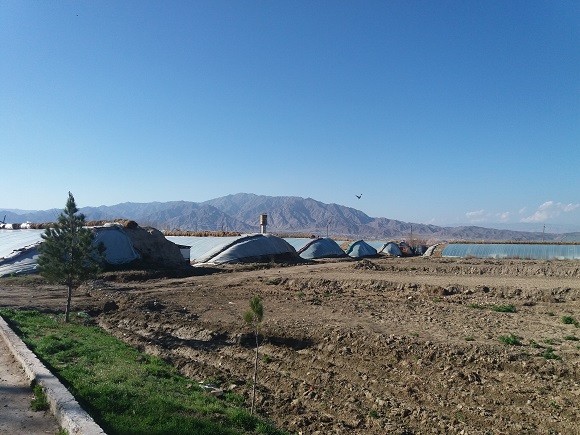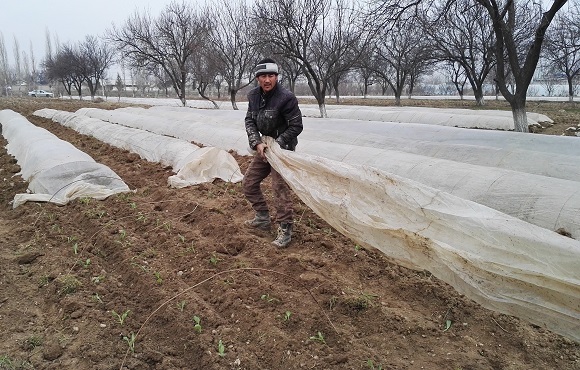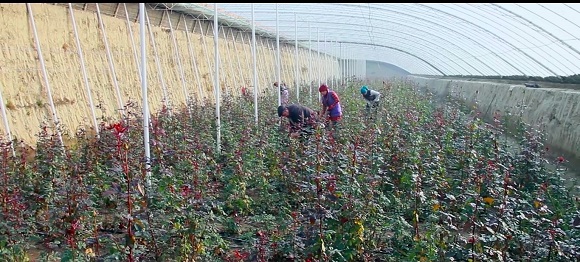-
About
- Our Work
- Get Involved
- Stay Updated
Life under plastic film: sufficient usage of land resources

The family Marupovs has been dealing with agriculture for many years. They have grown cotton and vegetables on rented plots of land of the Joint stock company “S.Urunkhojaev”. The work under a burning sun did not compensate input costs and moreover was a kind of a seasonal work. From November till the beginning of March, a waiting time with sitting at home, they used to spend away their accumulated sums. They hardly managed to prolong their family budget until the next coming season.
"My friend, who is an agronomist, recommended me to try my hands and change to a greenhouse business. Initially, I was a bit scared, because a greenhouse business was something that was new to me. But, they assist me, provide consultations and recommendations. Nowadays, I rent 6 hundred square meters of plot in a Chinese type greenhouse located inside of S.Urunkhojaev farm. So, in January I have planted tomatoes of the variety A9 and Saren. I also grow cucumbers, greens, and other types of decor flower seedlings" shared Marufjon, the head of the family Marupovs.
Right at the beginning nearly everybody is prone to scare. As Marufjon mentioned, a greenhouse business is a costly one, which demands higher input of costs. It is necessary to maintain a certain level of warmth and humidity. Blossoms of plants tend to fade if the temperature is low. One needs cellophane, cables, wire and hay for construction, and pipes for installation of dripping irrigation system. On top of these, there are input costs for operation. It is necessary to spend 5 to 6 years, in order to gain sufficient experience and skills in operation of greenhouses.
As for the specialists, they have another optimistic forecast. They strongly recommend striding towards this direction. One of the agronomist-consultants of PO “Neksigol Mushovir”, Makhsutjon Otabekov, underlines that greenhouse is one of the most effective ways of land usage. From the economic perspective it means the following:
- Land turn over the whole year round;
- Good sale prices in autumn, winter and spring seasons;
- Higher crop capacity gained from each square meter;
- Work is ensured during the winter season;
- 10 fold crop capacity in comparison to open ground.
On his mind, the more greenhouses the fewer risks of food security. In the direction of a greenhouse development one needs to pay sufficient attention for preparation of professional staff. Not be limited and construct bigger in size greenhouses of up to 3 hectares.
Currently, there are about 390 cold frames and greenhouses in Sugd region of the Republic of Tajikistan. Although, the figure might seem impressive, but the sizes are too small, which equal to about 25 hectares totally. The area is 100s fold less than the total area of agricultural lands.
“Many farmers still mix and don’t know the difference between cold frame and greenhouse. But still there is a big difference between them” – shares Makhsutjon Otabekov. “Cold frame is a covered by cellophane plot of land, where a man cannot enter to or work inside. Maximum height of cold frames is up to 1,5 meters, usually 0,70 meters. It is possible to grow only seedlings inside. Greenhouse is a kind of a separate construction with artificial coating. One can enter and work easily inside. Sometimes the height can reach up to 10 meters. They grow not only seedlings, but vegetables, cabbage, greens and citrus fruit trees inside”- added the agronomist Otabekov.
There exist different types of greenhouses worldwide, which mostly depend on application of cover materials and construction structure, i.e. industrial, standard, tunnel form, polycarbonate, glass, plastic film, heated and non-heated, temporary. Besides, there exist other types, such as those that are called Chinese, South Korean, Israel and Holland type. They have their own technical specifications for construction. Before, our farmers widely used industrial and standard types of greenhouses in Tajikistan. Since 2010 they have been constructing Chinese types, which number equals to 140 constructions out of the total number of greenhouses in the region. Judging by what the specialists say, they are more efficient in comparison with ordinary ones, and the temperature is three degrees higher in them. They are heated by the sun and do not have heating systems.

“The main question in growing process is to reach a biologically clean product” – outlines the Candidate of biologic science Akbar Mukhamedov. “Application of coatings, made of artificial materials, has its favorable impact on microclimate inside of greenhouses. This is a kind of a mechanical barrier against invasion of pests and infections. Also, this material restrains industrial dust and other possible contaminations. Only the dust contains a considerable amount of heavy metals, such as tin, cadmium, zinc, copper, iron, manganese etc., which are easily absorbed by vegetables”- added the biologist.
The term “favorable impact” means both positive impact of shelter on microclimate conditions and protection of plants against diseases and pests.
Also, installation of cleaning systems for filtering technical water used for irrigation, application of recirculation systems, and disinfection of nutrient solutions ensure raising the quality and ecological safety of growing products, as well as sufficient usage of water resources.
“In conditions of protected ground it is convenient to use biologic means for plant protection, as there are more favorable conditions for development of entomophages. Being once colonized during a longer period (the whole season), they stick to live inside of a greenhouse and control biological processes independently. Entomophages, without application of chemicals, can successfully help to struggle with pests, preserving yield, a higher quality and ecologically clean product” – says Akbar Mukhamedov.
According to the Candidate of Biological Sciences, there is possibility in Sugd region to apply organic fertilizers, which are not easily available, instead of saltpeter, because greenhouses occupy smaller areas of lands.
"There are not any possibilities for weeding seeds to get inside of a greenhouse by wind or water, just because it is covered with a film, and irrigation is carried out mainly by means of special filters of a dripping irrigation system, which filter water and help to get rid of weeding seeds. Therefore, usage of chemicals, such as herbicides, for struggling against weeds is not necessary to use in greenhouses,"- concluded Mukhamedov.

According to experts of the regional environment protection department, expansion of cold frames and greenhouses would provide possibility to effectively use renewable energy resources, and reduce emission of harmful substances into the atmosphere due to reduction in the use of solid and liquid energy materials.
Land and soil are the main natural resources, which gradually, day by day, tend to degrade due to erosion, salinity, high acidity and swampiness. Despite the high production growth, the region's food basket still depends on import. Based on economic efficiency and possibility to grow bio-ecologically clean products in greenhouses, it is worthwhile to expand lands for development of cold frames and greenhouses.
Photos credit: Khosiyatkhon Komilova
About the author
Related Posts
Comments
No comments made yet. Be the first to submit a commentBy accepting you will be accessing a service provided by a third-party external to https://www.ypard.net/
Get in touch
Email: [email protected]
YPARD Global Coordination UnitHosted by AGRIDEA and the Czech University of Life Sciences Prague
Lausanne, Switzerland and Prague, Czech Republic - Our Work

